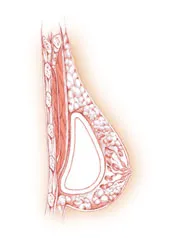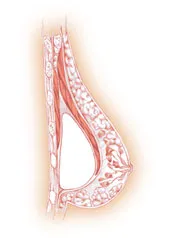Breast Implant Placement

Breast implants can be placed over or under the pectoralis muscle
The placement of your breast implants is a major consideration that will go a long way in determining your new appearance. Subglandular (over the muscle) placement results in a more distinct cleavage and rounded appearance, while many women feel that the subpectoral (partially under the muscle) and submuscular (under the muscle) placements result in a more natural look and feel.
Under or Over the Muscle Breast Implant Placements
During breast augmentation surgery, the plastic surgeon places the breast implant behind the breast and either over, partially under or completely under the pectoralis muscle. Placement under the muscle may reduce the chance of developing capsular contracture and interfere less with a mammogram. Your breasts will likely be "high," firm and possibly a bit uneven for up to several months before they settle into their permanent position.
Your surgeon will discuss his or her recommendation for implant placement during your consultation prior to surgery.
Subglandular (over the muscle)
Subglandular Placement
- Implant is placed in front of the chest muscle.
- More distinct cleavage, rounded appearance.
- Often chosen by women who work out.

Sometimes referred to as "overs," the subglandular implant placement involves placing the breast implant directly behind the mammary gland and in front of the pectoralis muscle. This placement results in a more distinct cleavage than the under the muscle placements, and the breasts may appear more rounded. Women who receive larger implants often choose this placement.
The surgery is less complicated than the under the muscle placements and offers the quickest recovery time. This placement also makes the implant easier to access if additional surgery is required.
The primary disadvantage of this placement is that the breast implants are more visible and more vulnerable to trauma without the protection of the pectoralis muscle. Over the muscle placement is usually not recommended for patients with little breast tissue, as rippling of the implant shell may be seen and felt through the skin. This visible wrinkling is more noticeable when textured implants are used. Also, chances of developing capsular contracture are higher with this placement.
Compared with under the muscle placement, subglandular placement makes breast cancer screening more difficult to perform. Women with breast implants should always alert the technician as to their presence when getting a mammogram. For more information, see our section on interference with mammography.
Women who are athletic, including bodybuilders and weightlifters, often choose this placement. With under the muscle placements, the implants can be distorted in shape or even damaged over time when the chest muscles are flexed.
Subpectoral (partially under the muscle)
Subpectoral Placement
- Implant is placed partially behind the chest muscle.
- More natural feel and appearance.
- Implant is completely covered.

Sometimes referred to as "partial unders," the subpectoral implant placement involves placing the upper two-thirds of the breast implant behind the pectoralis muscle. This placement results in a more natural feel and appearance than over the muscle placement. The breasts are usually less rounded, there is less cleavage and the upper portion of the breasts have a more natural shape.
Compared to over the muscle placement, the recovery time is usually longer and a little more discomfort is experienced with the subpectoral placement. This is due to the necessity of manipulating the muscles during surgery, which causes them to stretch. After surgery, the implant may take longer to drop into position due to swelling.
Breast cancer screening is less difficult to perform compared with over the muscle placement. Women with breast implants should always alert the technician as to their presence when getting a mammogram, as discussed in our section on interference with mammography.
Subpectoral placement decreases the risk of visible rippling of the implant shell, except for the lower third of the implant not covered by the muscle. Chances of developing capsular contracture are also lessened.
Women with small breasts often choose an under the muscle placement to provide more cover over the implant.
Submuscular (under the muscle)
Submuscular Placement
- Less common than the subglandular and submuscular placements.
- Implant is placed completely behind the chest muscle.
Sometimes referred to as "complete unders," the submuscular implant placement involves placing the breast implant directly behind the pectoralis muscle. This placement is currently less common than the subglandular and subpectoral placements.
With this placement, the upper portion of the implant is placed behind the pectoralis muscle and the fascia (connective tissue) that supports the muscle. The lower and outer portions of the implant are covered by the serratus muscles and fascia. The weight of the implant is supported by the fascia rather than the skin of the breast. This placement makes the implant more difficult to access if a revisional procedure is required.
Because more muscles are manipulated and stretched, this placement usually results in the longest surgery, the longest recovery time and the most discomfort after surgery.
This placement is the best for breast cancer screening because the implant is completely behind the area that is examined. Women with breast implants should always alert the technician as to their presence when getting a mammogram. For more information, see our section on interference with mammography.
Since the implant is completely covered by muscle and fascia, submuscular placement carries the least risk of rippling of the implant shell. The chance of developing complications such as capsular contracture and bottoming out is also lessened.
